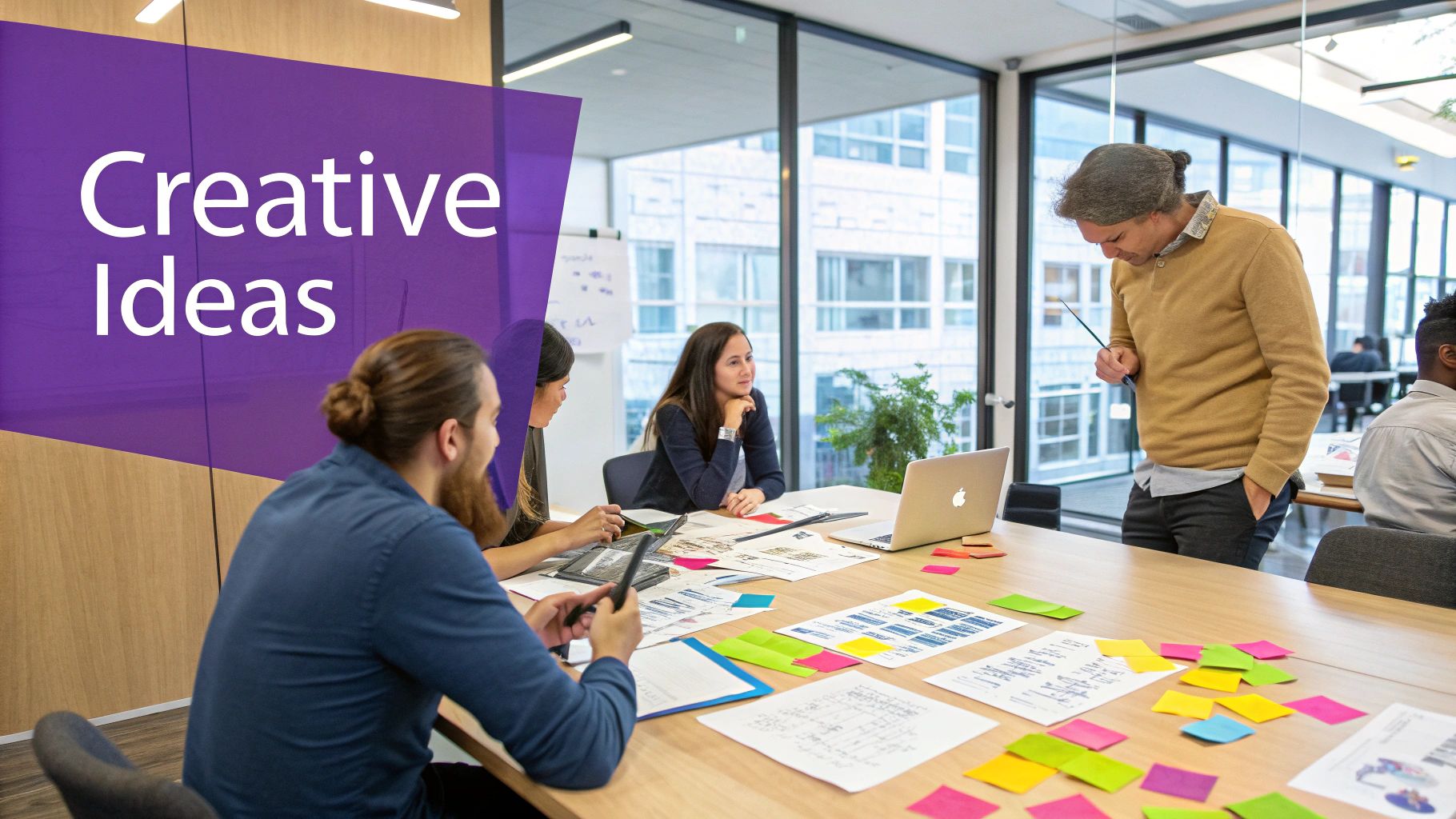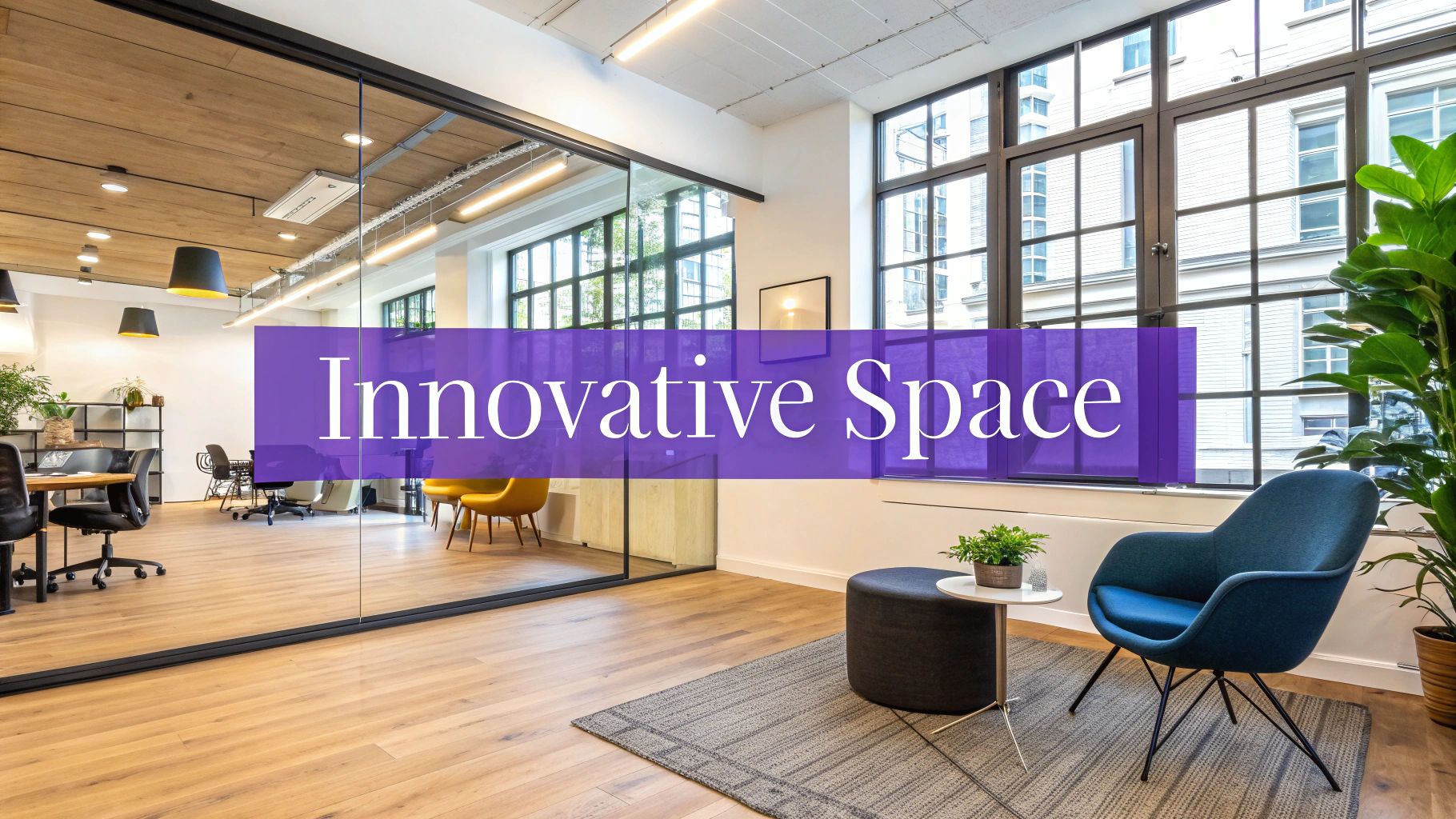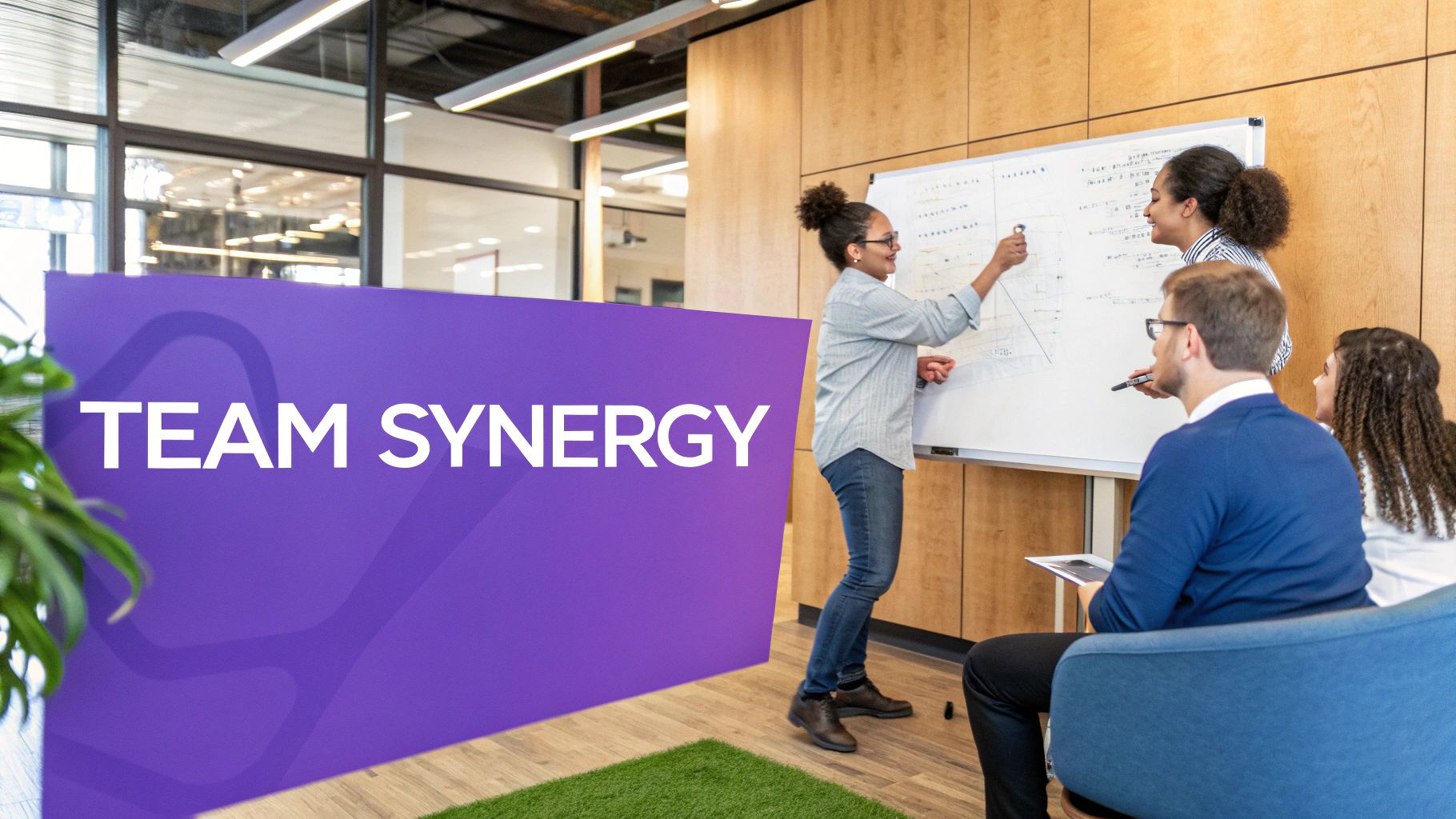Why Systematic Idea Generation Fuels Business Success

In today’s competitive business landscape, innovation is essential for growth. True innovation isn’t about sudden inspiration; it’s about systematic idea generation. This structured approach makes creativity a repeatable process.
This proactive strategy helps businesses constantly find opportunities and adapt to changing market demands. The results? Increased market share, better profits, and stronger brand recognition.
The Power of Predictable Innovation
Imagine relying on chance or sporadic brainstorming for new ideas. This unpredictable approach leads to inconsistent results and missed opportunities. That’s where systematic idea generation comes in.
By establishing structured processes and dedicating resources, businesses can create a culture of continuous innovation. Think regular ideation workshops, dedicated innovation teams, or using idea management software. These create a steady flow of potential concepts.
This reliable stream of ideas helps businesses anticipate market shifts and outperform competitors.
Turning Ideas Into Actionable Strategies
Systematic idea generation isn’t just about lots of ideas. It’s about crafting actionable strategies aligned with business goals. This involves strong evaluation to filter and prioritize ideas based on feasibility, potential impact, and strategic fit.
Realistically, not every idea is a winner. Research shows only 6% of officially proposed ideas succeed commercially. This rises to 14% for ideas reaching development. This emphasizes the importance of a strong evaluation process alongside idea generation. Learn more at Inc.com.
A structured approach ensures resources go to the most promising concepts, maximizing the return on innovation efforts.
Cultivating a Culture of Continuous Improvement
A well-defined ideation process empowers teams to generate a wider range of ideas. This diversity expands the possibilities for breakthroughs. Plus, a systematic approach fosters a culture of continuous improvement.
It encourages everyone to contribute their perspectives. This collective creativity unlocks unexpected solutions and drives significant business growth. Embracing systematic idea generation isn’t just about the next big thing; it’s about building a sustainable engine for ongoing success.
Building Teams That Generate Breakthrough Ideas

Generating innovative ideas takes more than just individual brainstorming. It requires the right team dynamics. The way your team is structured significantly influences the quality of ideas generated in business. This section explores how team dynamics, from diversity to communication styles, impact the ideation process.
The Impact of Diversity on Idea Generation
Teams with diverse backgrounds and perspectives tend to generate more creative and innovative ideas. This diversity can come in many forms:
- Cognitive Diversity: This includes different thinking styles and ways of solving problems.
- Demographic Diversity: This refers to differences in age, gender, ethnicity, and cultural backgrounds.
- Experiential Diversity: This encompasses a range of professional and personal experiences.
For example, imagine a team with members from various industries tackling a product development challenge. This variety of input can help break away from traditional thinking and lead to more original solutions.
Let’s take a look at the following table to further understand the impact of team composition on idea generation.
To illustrate these concepts, let’s consider how various team compositions impact idea generation. The table below summarizes research findings, comparing different factors and their influence on idea quality, implementation challenges, and best practices.
Team Composition Impact on Ideation Quality
| Team Composition Factor | Impact on Idea Quality | Implementation Difficulty | Best Practices |
|---|---|---|---|
| Homogenous Team (similar backgrounds) | Can lead to quicker initial agreement, but may limit creativity and innovation. | Easier to manage initially, but may encounter groupthink challenges. | Encourage diverse perspectives through external input and structured brainstorming techniques. |
| Diverse Team (varied backgrounds and experiences) | Fosters a wider range of ideas and perspectives, leading to more creative solutions. | Can be more challenging to manage initially due to differing perspectives. | Facilitate open communication and collaboration. Establish clear decision-making processes. |
| Cross-Functional Team (members from different departments) | Brings together specialized knowledge and skills, enhancing problem-solving capabilities. | Requires careful coordination and communication across different functions. | Clearly define roles and responsibilities. Encourage cross-functional knowledge sharing. |
| Remote Team (members located in different geographical areas) | Can broaden the talent pool and offer diverse perspectives. | Requires dedicated communication and collaboration tools and strategies. | Implement virtual brainstorming and communication platforms like Bulby. Foster a sense of community and shared purpose. |
As the table shows, diverse teams, while sometimes more challenging to manage, ultimately produce more innovative ideas. Each type of team presents its own unique strengths and challenges. Recognizing these differences can help in implementing the right strategies to boost ideation quality.
Communication: The Key to Unlocking Creativity
Effective communication is essential for successful idea generation. Open and honest communication creates psychological safety, enabling team members to share ideas freely.
Active listening is another vital aspect, ensuring everyone’s ideas are heard and considered. Techniques like structured brainstorming sessions can be useful, giving each member an equal chance to contribute. This creates an inclusive environment and fosters a richer collection of ideas. For further guidance, check out this helpful resource: How to master an ideation framework.
The types of personalities within the team also play a role. Research shows that interacting with extroverted colleagues leads to better-rated ideas. The impact of extroversion was statistically significant, proving how team dynamics influence the idea generation process. Explore this topic in more detail here.
Fostering a Culture of Productive Ideation
Building a team that excels at idea generation involves more than just assembling a diverse group. It requires cultivating a culture of productive ideation. This involves several key elements:
- Embrace Risk-Taking: Encourage team members to share unconventional ideas without fear of negative consequences.
- Facilitate Collaboration: Implement tools and processes that promote collaboration and knowledge sharing. Platforms like Bulby can greatly enhance idea generation, particularly for remote teams.
- Provide Constructive Feedback: Create a feedback system that’s both supportive and challenging, helping to refine and improve ideas. Here’s a helpful resource on ideation frameworks: How to master an ideation framework.
This supportive environment helps overcome challenges like conformity and idea suppression, which can hinder idea generation. By focusing on these elements, organizations can transform brainstorming sessions into truly exceptional ideation experiences.
Tech-Powered Idea Generation: Beyond Basic Brainstorming

The business world is constantly changing. Fresh perspectives and continuous innovation are essential for success. Traditional brainstorming, while useful, can sometimes feel limited in our fast-paced environment. That’s where technology comes in. It offers powerful tools to improve how we generate ideas. These tools help teams move beyond basic brainstorming and reach new levels of creativity and efficiency.
Leveraging AI and Machine Learning for Enhanced Ideation
Artificial intelligence (AI) and machine learning are changing the way businesses develop new ideas. These technologies analyze large amounts of data, identify patterns, and offer valuable insights. These insights would be very difficult, if not impossible, for humans to discover on their own.
AI, for instance, can analyze market trends, understand consumer behavior, and study competitor data. This analysis helps businesses identify opportunities for new products or services. AI-powered tools also assist in the ideation process itself.
Platforms like Bulby provide structured brainstorming exercises and AI-guided prompts. These features help teams break through creative blocks and generate a wider variety of ideas. This structured approach helps remote teams collaborate effectively and share their unique perspectives.
The Power of Crowdsourcing and Digital Collaboration
Crowdsourcing and AI are becoming increasingly valuable for generating business ideas. Crowdsourcing allows businesses to gather input from many different sources, potentially uncovering unmet customer needs. Combining AI tools with crowdsourcing helps sort and refine these ideas, enabling faster identification of concepts with strong potential. AI can process vast datasets to identify patterns and trends, which helps prioritize and develop promising ideas. This combined approach of human input with technology improves the chances of generating valuable ideas. Learn more about this at Wellspring.
Digital collaboration tools also play a key role. These tools enable seamless communication and idea sharing across different locations. Teams can work together in real time, regardless of where they are. This creates a more dynamic and inclusive ideation process. Features like virtual whiteboards and collaborative document editing enhance the brainstorming experience. This ensures everyone has a chance to actively participate and contribute.
Integrating Technology Into Existing Workflows
While the benefits of technology are clear, successful integration requires a thoughtful approach. Start by understanding the specific challenges your business faces in generating new ideas. Then, find and select the tools that best address those challenges. If your team struggles with remote collaboration, for example, a platform like Bulby might be helpful.
It’s important to consider how new technologies will fit into your existing workflows. Choose tools that are user-friendly and easy to integrate to minimize disruptions to your current processes. Provide training and support so your team can use the tools effectively and reach their full potential.
Addressing the Limitations of Tech-Driven Ideation
Technology offers incredible potential. However, it’s important to acknowledge its limitations. AI and machine learning algorithms are only as effective as the data used to train them. This means that biased data can lead to inaccurate results.
Technology should also not entirely replace human creativity and intuition. It should be used as a tool to enhance human capabilities, not to replace human input. The most effective approach combines the power of technology with human ingenuity. This creates a strong partnership that drives true innovation. By understanding and addressing these limitations, businesses can unlock the full potential of technology to generate game-changing ideas.
Idea to Impact: Evaluation Frameworks That Work

Generating innovative ideas is only the first step. The real challenge lies in figuring out which ideas have the potential to thrive. This evaluation process is what sets market leaders apart. It involves examining concepts through several key perspectives: market potential, feasibility, strategic alignment, and resource requirements. This section explores proven frameworks to evaluate ideas, transforming them from initial concepts into impactful strategies.
Key Frameworks for Evaluating Business Ideas
Several frameworks can help evaluate the viability of business ideas. These frameworks offer structured approaches for businesses to systematically assess their ideas’ potential. One common approach is the weighted scoring model. This model assigns weights to different criteria based on their relative importance.
For example, market size might have a higher weight than development cost for a growth-focused company. Another effective framework is the SWOT analysis. This assesses an idea’s strengths, weaknesses, opportunities, and threats. A SWOT analysis provides a comprehensive overview of an idea’s potential and possible challenges.
Systematic Filtering and Refinement
Successful companies use systematic processes to filter and refine their ideas. This starts with clearly defining the evaluation criteria. These criteria must align with the company’s overall strategic goals. This ensures that resources are invested in ideas that support long-term objectives.
Next, promising ideas are thoroughly investigated. This might involve market research, competitor analysis, and feasibility studies. This deep dive clarifies an idea’s potential and uncovers hidden risks. It’s important to balance data analysis with intuition, which can sometimes drive groundbreaking innovation. For further insights, read: How to master creative problem-solving techniques.
The filtering process can have multiple stages. Initial screening removes ideas that don’t meet basic criteria. More detailed analysis then assesses the remaining ideas. This multi-stage approach efficiently identifies the most promising concepts. Turning ideas into successful businesses is statistically challenging. Over five million new ventures were created in 2022, but only about two in five become profitable. This underscores the importance of rigorous idea evaluation. More detailed statistics can be found here.
Practical Templates and Pitfalls to Avoid
Several practical templates can aid idea evaluation. A common tool is the idea evaluation matrix. This matrix outlines key criteria and uses a structured scoring system. This allows teams to compare different ideas objectively and pinpoint those with the highest potential.
Before introducing the matrix, let’s discuss its purpose. This matrix offers a systematic way to evaluate different ideas against a set of predetermined criteria. This ensures objectivity and facilitates comparison.
| Evaluation Criterion | Weight | Assessment Questions | Scoring Guide |
|---|---|---|---|
| Market Size | 30% | What is the total addressable market? What is the potential market share? | 1-5 (1=Low, 5=High) |
| Feasibility | 25% | Is the idea technically feasible? Are the resources available? | 1-5 (1=Low, 5=High) |
| Strategic Alignment | 20% | Does the idea align with the company’s strategic goals? | 1-5 (1=Low, 5=High) |
| Required Resources | 15% | What resources (financial, human, technological) are needed? | 1-5 (1=Low, 5=High) |
| Competitive Landscape | 10% | What is the competitive landscape? What are the barriers to entry? | 1-5 (1=Low, 5=High) |
The matrix above provides a framework for evaluating new ideas. Remember to adjust the weights and criteria based on your specific business context.
Even with robust frameworks, pitfalls exist. One common mistake is dismissing unconventional ideas too quickly. Breakthrough innovations often come from thinking outside the box. Another pitfall is overemphasizing data at the expense of intuition. While data is essential, relying solely on it can hinder creativity and lead to missed opportunities.
Balancing Data and Intuition in Evaluation
The best evaluation process balances data-driven assessment with team intuition and experience. Data offers valuable insights into market trends and customer needs. Intuition, however, can identify potential opportunities that data might miss. This blend of analytical rigor and creative thinking helps organizations find ideas that are both innovative and commercially viable. For more on creative problem-solving, check out this resource: How to master creative problem-solving techniques. This approach allows businesses to assess an idea’s potential for significant market impact.
Building a Culture Where Great Ideas Thrive
Even the best brainstorming sessions can fall flat without the right company culture. This section explores how your work environment can either nurture or stifle creativity, focusing on leadership, structure, incentives, and common roadblocks.
Leadership’s Role in Fostering Innovation
Leaders have a big impact on company culture. Their actions and attitudes directly influence how team members view and approach innovation. Leaders who encourage experimentation and welcome new ideas cultivate a fertile ground for creativity. On the other hand, leaders who cling to the status quo and resist change can quickly stifle innovation.
This means building a culture of idea generation starts at the top. Leaders should actively champion innovation, dedicating resources and offering support for new initiatives. Leading by example is also key. When leaders embrace calculated risks and view failures as learning experiences, it sets the tone for the entire organization.
Designing Organizational Structures That Support Continuous Innovation
How your organization is structured also plays a vital role in idea generation. Traditional hierarchical structures with rigid reporting lines can hinder the free flow of ideas. Flatter, more agile structures tend to foster better collaboration and encourage open idea sharing.
Some companies create dedicated innovation teams or departments to explore new ideas and develop innovative solutions. Others implement cross-functional teams, bringing together people with diverse skills to collaborate on projects. This mix of perspectives can lead to exciting breakthroughs. Check out our guide on how to boost creativity for more tips.
Incentivizing Consistent Ideation and Overcoming Cultural Barriers
The right incentives are key for motivating consistent idea generation. Recognizing and rewarding employees for their valuable ideas encourages continued participation. Rewards can be financial, like bonuses, or non-monetary, like public acknowledgment or professional development opportunities.
But even with incentives, cultural barriers can still get in the way. Fear of failure is a common one. Employees might hesitate to share ideas if they’re worried about being penalized for suggestions that don’t pan out. Excessive bureaucracy is another obstacle. Complicated approval processes can discourage people from submitting new ideas in the first place.
Transforming Risk-Averse Teams into Innovation Engines
Changing a risk-averse culture into one that embraces innovation takes a multi-pronged approach. It begins with fostering psychological safety within teams. Team members need to know it’s okay to take risks and that failures are seen as learning opportunities. This requires clear communication from leadership and a commitment to building a supportive atmosphere.
Streamlining decision-making processes and reducing bureaucracy can also empower teams to act quickly and experiment. Providing training and resources on idea generation techniques gives employees the skills and confidence to contribute more effectively. This makes idea generation part of the company’s DNA, creating a thriving environment where new ideas consistently emerge.
Matching Idea Generation Methods to Business Challenges
One-size-fits-all rarely works, especially when it comes to generating new ideas. Different business challenges require different approaches. This section explores how to match specific challenges with the most effective idea generation techniques. We’ll cover product development, process improvement, market expansion, and strategic pivots. For each method, we’ll discuss implementation, resources, expected outcomes, and real-world examples, providing a practical guide for your needs.
Product Development: Unearthing the Next Big Thing
Several techniques stand out when developing new products. SCAMPER is a checklist that prompts you to Substitute, Combine, Adapt, Modify/Magnify/Minify, Put to other uses, Eliminate, and Reverse. This can unlock creative modifications to existing products or spark entirely new concepts. Design thinking, a human-centered approach, emphasizes understanding user needs and prototyping solutions quickly. This iterative process helps ensure products resonate with the target market.
Process Improvement: Streamlining for Efficiency
When your goal is process improvement, methods like Six Thinking Hats and Kaizen are valuable. Six Thinking Hats encourages exploring a challenge from different perspectives (logical, emotional, creative, etc.), leading to well-rounded solutions. Six Thinking Hats is a powerful tool for analyzing situations from multiple angles. Kaizen, focused on continuous, incremental improvement, helps teams identify and eliminate waste within existing processes, ultimately driving efficiency gains. Kaizen is a philosophy of continuous improvement.
Market Expansion: Identifying Untapped Potential
Expanding into new markets requires understanding your target audience and the competitive landscape. Market research and competitive analysis are crucial. Tools like Porter’s Five Forces can help you analyze competitive dynamics and identify attractive market segments. Porter’s Five Forces is a framework for industry analysis. A SWOT analysis (Strengths, Weaknesses, Opportunities, and Threats) can help assess your company’s position in the new market.
Strategic Pivots: Navigating Change and Uncertainty
Strategic pivots require bold thinking and a willingness to challenge existing assumptions. Scenario planning helps anticipate potential market shifts and develop flexible strategies. The Blue Ocean Strategy framework encourages exploring uncontested market spaces to create new demand. Blue Ocean Strategy focuses on creating new market spaces rather than competing in existing ones. Techniques like the Pre-Mortem analysis can help identify potential pitfalls early on, ensuring a smoother transition.
Combining and Adapting Techniques
Complex business challenges often benefit from combining approaches. For example, a company developing a new product for a new market might use design thinking for product development and Porter’s Five Forces for market analysis. Adapting techniques is also crucial as projects evolve. Early-stage ideation might benefit from brainstorming and mind-mapping, while later stages might require more structured approaches like an evaluation matrix.
The Power of Collaboration and Technology
Throughout all these methods, effective collaboration is essential. Tools like Bulby can enhance team communication and idea sharing, especially for remote teams. Effective idea generation isn’t a one-time event; it’s a continuous process. By matching the right methods to your specific challenges, you can create a culture of continuous innovation and drive business growth.
Ready to transform your team’s brainstorming sessions? Visit Bulby and discover the power of AI-guided brainstorming for remote teams. Unlock your team’s full creative potential today.

